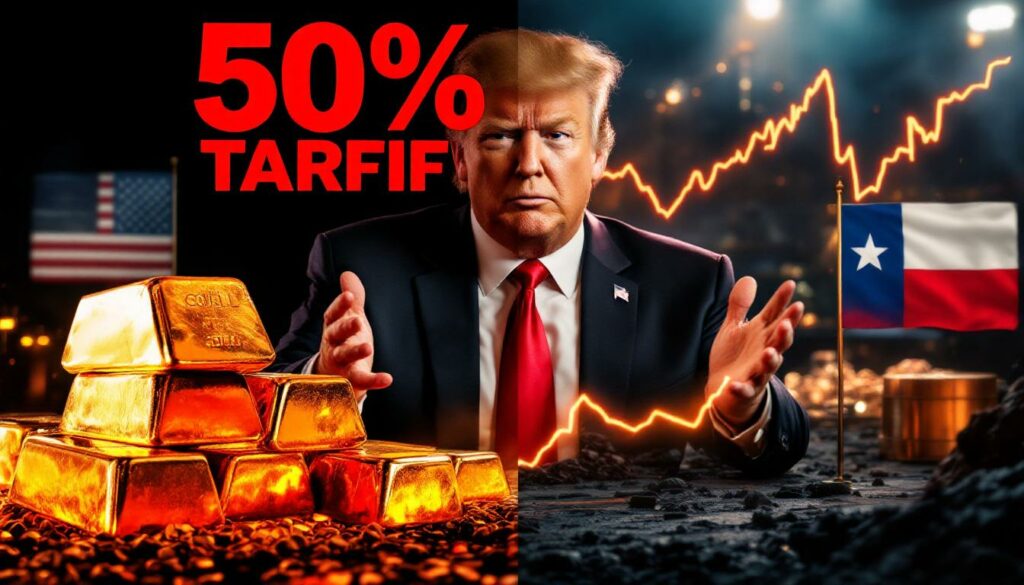Understanding Trump's Copper Tariff Bombshell
On July 8, 2025, President Trump stunned global markets with his surprise announcement of a 50% tariff on copper imports. This bombshell declaration sent immediate shockwaves through the commodities sector, with US Comex copper futures skyrocketing more than 12% to reach an unprecedented $5.9535 per pound in New York—an all-time record high for the essential industrial metal.
The announcement came without warning and caught both industry players and trading partners completely off guard. Particularly notable was the lack of specific details regarding which copper products would fall under the tariff regime—leaving market participants to speculate whether it would apply to refined copper, copper concentrates, or semi-finished copper goods.
"The markets are reacting to the uncertainty as much as to the tariff itself," noted several industry analysts observing the price volatility in the days following the announcement.
Adding to the confusion, Trump's declaration provided no clarity on whether certain countries might receive exemptions or when the tariff would actually take effect. This information vacuum has created a climate of uncertainty that has market participants scrambling for answers.
Immediate Market Impact
The immediate price surge reflects both speculative trading and genuine concerns about future supply constraints in the US market. American manufacturers and fabricators who rely on copper inputs are particularly concerned about cost increases that could ripple through supply chains.
Several market indicators suggest US companies may be considering emergency stockpiling behaviors to secure copper supplies before any tariff implementation, further driving short-term price volatility and potentially creating artificial shortages.
Key market movements following the announcement:
- 12%+ jump in US Comex copper futures
- Record high copper price of $5.9535/lb in New York
- Increased trading volumes across all copper contracts
- Widening spread between US and international copper prices
Codelco's "Wait-and-See" Response Strategy
Chile's state-owned copper giant Codelco has adopted a deliberately cautious approach to Trump's announcement. As the world's largest copper producer, the company finds itself in a complex position, balancing uncertainty with strategic planning.
Initial Reaction from Codelco Leadership
Codelco Chairman Máximo Pacheco articulated the company's measured stance in his first public comments following the tariff announcement: "What we need to do is understand what this is about. What products are affected? … Then, we have to see whether this will apply to all countries or only some."
This careful response highlights the mining giant's priority of gathering complete information before taking any definitive action. Pacheco further elaborated on the company's approach, noting: "We've always known that exceptions are made, and therefore, I think it's premature to comment."
Behind this measured public stance, Codelco executives are undoubtedly analyzing various scenarios and potential responses, while recognizing the fluidity of trade policy and the possibility of negotiated exemptions or modifications.
Strategic Considerations for Chile's State Miner
Codelco's relatively limited exposure to the US market—less than 7% of its refined copper exports—provides some insulation from immediate impacts. This diversified export profile gives the company breathing room to develop a comprehensive response strategy.
However, Codelco faces this challenge at a difficult moment in its operational history. The company's copper production has fallen to a 25-year low, complicating any potential need to redirect shipments or adjust production schedules. These operational constraints create a complex backdrop for strategic decision-making.
Codelco's strategic considerations include:
- Evaluating contract flexibility for potential shipment redirection
- Assessing pricing implications for different export markets
- Analyzing the competitive landscape if tariffs are selectively applied
- Balancing production challenges with market uncertainty
Internally, Codelco's leadership is likely conducting scenario planning for various outcomes while maintaining its public wait-and-see posture—a prudent approach given the limited information currently available.
Chile's Position as a Copper Exporter
As the global copper superpower, Chile finds itself in a unique position regarding Trump's tariff announcement. The country accounts for approximately 28% of global copper production and serves as the single largest copper supplier to the United States, creating both vulnerability and potential leverage in any trade war impact.
Chile's Relationship with US Copper Markets
While the United States represents an important market for Chilean copper, the country's export profile is significantly diversified. Less than 7% of Chile's refined copper exports go to American buyers, with China absorbing approximately 60% of the country's copper exports.
This diversification provides Chile with important flexibility in responding to potential trade disruptions. Nevertheless, the Chilean government has been quick to establish diplomatic channels to address the situation. The country's Foreign Ministry confirmed they "continue to be in contact and dialogue… with competent authorities" regarding the tariff announcement.
This isn't the first time Chile has navigated US trade actions targeting copper. The country previously joined Canada and Peru in pushing back against earlier probes initiated by the Trump administration targeting copper imports.
Export Diversification Advantages
Chile's copper export strategy has prioritized market diversification for decades, positioning the country to weather trade disruptions more effectively than more concentrated exporters:
Chile's copper export market distribution:
- China: ~60% of exports
- European Union: ~15% of exports
- Japan and South Korea: ~10% of exports
- United States: <7% of refined copper exports
- Other markets: ~8% of exports
This distribution pattern means Chile could potentially redirect US-bound shipments to alternative markets with relatively minimal disruption. The country's long-standing trade relationships across Asia and Europe provide established channels for such adjustments.
Additionally, Chile's copper industry has developed flexibility in product mix, producing everything from copper concentrates to refined cathodes and semi-finished products, allowing for adaptation to shifting market demands and trade barriers.
Broader Market Implications and Industry Response
The copper industry has responded to Trump's tariff announcement with a mix of concern about market distortions and skepticism about practical implementation.
Industry Perspectives on the Tariff Announcement
SONAMI president Jorge Riesco, representing Chile's mining industry, expressed serious concerns about the potential for market volatility. His assessment highlighted the fundamental challenge facing US policy: "The US lacks capacity for self-sufficiency and relies heavily on Chinese smelting and refining."
This reality underscores a critical weakness in the tariff strategy—American manufacturing cannot simply switch to domestic copper sources, as the US lacks sufficient mining and processing capacity to meet its needs.
Market analysts have suggested the tariff announcement may be primarily designed as a negotiating tactic rather than a definitive policy, pointing to previous instances where tariff threats were used to secure trade concessions in other sectors.
Supply-Demand Dynamics in the Global Copper Market
Codelco's own forecasts anticipate global rising copper demand growing approximately 3% annually in the coming years, driven by electrification trends, renewable energy expansion, and infrastructure development. Meanwhile, supply growth remains constrained by:
- Declining ore grades at existing mines
- Limited new project development
- Extended timelines for bringing new production online (10-15 years)
- Technical challenges in rapidly scaling copper output
This widening supply gap was already creating upward pressure on copper prices before the tariff announcement, with Codelco reporting "flat output" across the industry despite rising demand.
The table below illustrates the key supply-demand metrics shaping the global copper landscape:
| Metric | Value | Trend |
|---|---|---|
| Global copper demand growth | ~3% annually | Increasing |
| New mine development timeline | 10-15 years | Stable |
| Global production growth | Flat year-over-year | Constrained |
| Codelco's current production | 25-year low | Declining |
| US copper import dependency | High | Stable |
| US Comex copper price after announcement | $5.9535/lb | Sharp increase |
This supply-demand imbalance creates fundamental constraints on how quickly the US could shift to domestic sources, even with strong policy incentives.
US Copper Dependency and Market Realities
The United States faces significant structural challenges in reducing its reliance on imported copper, creating tensions between the tariff policy and industrial realities.
America's Growing Copper Requirements
Copper demand in the US is projected to increase substantially in coming years, driven by several factors:
- Electric vehicle production: Each EV requires approximately 83kg of copper, more than twice the amount used in conventional vehicles
- Grid modernization: Upgrading power infrastructure requires substantial copper inputs
- Renewable energy: Wind and solar installations are highly copper-intensive
- Defense applications: Military systems rely heavily on copper components
- Consumer electronics: Continued growth in devices requiring copper circuitry
As Codelco Chairman Pacheco noted: "The United States… will continue to need even more copper" to support these growing applications. This increasing demand comes at a time when global competition for copper resources is intensifying, particularly from China and other manufacturing centers.
Domestic Production Limitations
The US faces multiple constraints in expanding domestic copper production:
- Processing bottlenecks: The US imports approximately 40% of its refined copper from China due to limited domestic refining capacity
- Development timelines: New mines typically require 10-15 years from discovery to production
- Regulatory hurdles: Permitting processes for new mines face multiple challenges
- Infrastructure limitations: Inadequate transportation and energy infrastructure in potential mining regions
- Resource quality: Many remaining US copper deposits have lower grades requiring more intensive processing
These factors create a fundamental disconnect between the tariff policy and the practical realities of US copper supply chains. Even with strong incentives, domestic production cannot rapidly expand to fill the gap created by restricting imports.
"The physics and economics of mining simply don't allow for quick production increases," noted one industry expert. "You can't turn copper mines on and off like a manufacturing facility."
Potential Outcomes and Future Scenarios
Given the complexity of global copper markets and trade relationships, several potential pathways could emerge from the current situation.
Possible Exemption Pathways
Historical precedent suggests country-specific exemptions may eventually materialize. When the Trump administration implemented steel tariffs in 2018, several key allies eventually received exemptions through various mechanisms:
- Bilateral negotiations: Direct country-to-country discussions leading to specific exemptions
- Alternative arrangements: Quotas or other restrictions replacing tariffs
- Strategic partnerships: Exemptions based on security or defense considerations
- Legal challenges: WTO or treaty-based dispute resolution
Chile may pursue exemption through highlighting its status as a reliable trade partner and the strategic importance of maintaining copper supply chains. The country's Foreign Ministry has already initiated "contact and dialogue" with relevant US authorities, suggesting diplomatic channels are active.
Long-term Strategic Adjustments
Beyond immediate responses, the tariff announcement could trigger several longer-term adjustments in global copper markets:
- Accelerated diversification: Chilean producers may accelerate efforts to develop non-US markets
- Investment shifts: Capital allocation decisions could prioritize operations serving non-US customers
- Supply chain reconfiguration: Processing and refining capacity might develop in countries exempt from tariffs
- Pricing mechanisms: New premium/discount structures could emerge for US versus non-US copper
- Trade flow adjustments: Complex rerouting of copper shipments through third countries
These strategic shifts would likely unfold gradually, with companies balancing short-term disruption management against longer-term strategic positioning.
What This Means for Global Copper Markets
The tariff announcement's implications extend far beyond US-Chile trade relations, potentially reshaping global copper markets in several ways.
Price Implications and Volatility Factors
Market analysts anticipate continued price volatility as participants adjust to the new landscape. Key price effects include:
- Short-term price spikes: Driven by uncertainty and potential stockpiling
- Regional price differentials: US prices potentially remaining elevated versus international benchmarks
- Contract adjustments: Renegotiation of long-term supply agreements incorporating tariff risk
- Derivatives market impact: Increased hedging activity as buyers seek price protection
The record $5.9535/lb price reached after the announcement may represent just the beginning of a period of unusual price dynamics as markets digest the implications and adjust trading strategies.
For copper consumers, particularly in manufacturing and construction, these price effects could drive significant cost increases and supply chain disruptions, potentially forcing product redesigns or material substitution where possible.
Supply Chain Reconfiguration Possibilities
Global copper flows may undergo significant reconfiguration in response to tariffs:
- Triangular trade patterns: Copper potentially moving through third countries to access US markets
- Processing location shifts: Smelting and refining capacity potentially developing in new locations
- Product transformation: Greater conversion to semi-finished products less affected by tariffs
- Market segmentation: Emergence of distinct supply chains serving US versus non-US markets
These adjustments would likely increase inefficiency in global copper movement, potentially raising overall costs and environmental impacts while creating opportunities for countries positioned as alternative suppliers or processing hubs.
FAQ: Key Questions About the Copper Tariff Situation
When would the 50% tariff take effect?
Trump's announcement did not specify an implementation timeline. Typically, tariffs require formal rule-making processes that can take weeks or months to complete, though emergency measures can be implemented more quickly.
Which specific copper products would be affected by the tariff?
The announcement lacked product-specific details. Tariffs could potentially apply to raw copper ore, concentrates, refined copper cathodes, or semi-finished copper products. Each category would have different supply chain implications.
Are any countries likely to receive exemptions?
Historical precedent suggests exemptions are possible. Countries with free trade agreements or strategic partnerships with the US may pursue exemptions through diplomatic channels or formal trade dispute mechanisms.
How might this impact copper prices globally?
Beyond the immediate 12% price spike, long-term effects depend on implementation details. Market segmentation could develop between US and non-US prices, with potential arbitrage opportunities emerging between markets.
What options does Codelco have to mitigate tariff impacts?
With less than 7% of refined exports going to the US, Codelco has significant flexibility to redirect shipments to other markets. The company may also explore product transformation strategies or joint ventures in countries with preferential US access.
Could the US develop sufficient domestic copper production?
Significant expansion of US copper production would require 10-15 years of development time plus substantial investment in refining capacity. The US copper investment outlook currently lacks the infrastructure to become self-sufficient in the short or medium term.
Global Copper Supply and Demand Metrics (2025)
| Metric | Value | Trend |
|---|---|---|
| Global copper demand growth | ~3% annually | Increasing |
| US copper import dependency | High | Stable |
| Chile's share of US copper imports | Largest single supplier | Stable |
| Chile's exports to US as % of total | <7% of refined copper | Stable |
| Codelco's current production | 25-year low | Declining |
| US Comex copper price after announcement | $5.9535/lb | Sharp increase |
| Global copper production growth | Flat year-over-year | Constrained |
The copper price prediction metrics indicate continued volatility, while experts continue to monitor how ASX copper stocks response might provide early indicators of market direction. According to top copper nation Chile's concerns, this situation creates significant economic uncertainty for their largest export industry.
Disclaimer: This analysis represents the current understanding of an evolving situation. Implementation details of the proposed tariff remain unclear, and market conditions continue to develop rapidly. Investors and industry participants should conduct their own due diligence regarding potential impacts on specific businesses and investments.
Looking for the Next Major Mineral Discovery?
Discovery Alert's proprietary Discovery IQ model instantly notifies investors of significant ASX mineral discoveries, transforming complex data into actionable insights that could lead to substantial returns. Visit Discovery Alert's dedicated discoveries page at https://discoveryalert.com.au/discoveries/ to understand why historic discoveries can generate exceptional market outcomes and begin your 30-day free trial today.




